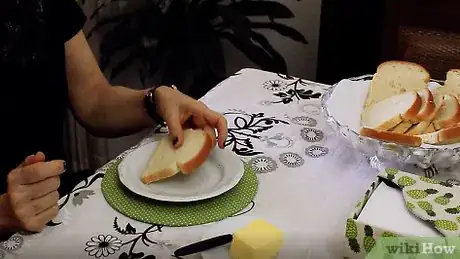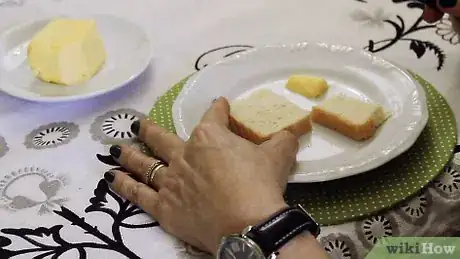This article was co-authored by Sarena Nelson. Sarena Nelson is a Private Chef and the Founder of Chef Sarena, based in Palm Springs, California. With over 10 years of experience, she specializes in customized menus for private events, has worked in 5-star restaurants, and has helped small restaurants redesign their menus. She earned her degree from Le Cordon Bleu School of Culinary Arts in Pasadena, California.
There are 8 references cited in this article, which can be found at the bottom of the page.
This article has been viewed 53,626 times.
If you are at a dinner party and are curious about bread and butter etiquette, remember to take one roll at a time, tear the roll into bite-size pieces, and butter each bite individually. If your butter is very hard, you can soften it by leaving it on the counter, spreading it across a plate with your knife, grating it, or placing a warm glass over it. Simply scoop up your butter with a butter knife, and spread it across your bread in light, soft strokes.
Steps
Following Bread and Butter Etiquette
-
1Pick up one roll or slice from the serving tray. If you are at a dinner party and someone passes you the basket of bread, avoid taking multiple rolls at the same time. Select one for now, and then pass the basket to your right.[1]
- If you want another piece of bread, you can get a second after everyone else has a piece.
-
2Place the roll on your bread plate or dinner plate. To follow proper etiquette, put your roll onto the small plate toward the top left of your dinner plate. If you do not have a bread plate, you can place it on your dinner plate wherever you have room.[2]Advertisement
-
3Scoop up a small slice of butter and put it on your plate. Instead of buttering your roll directly, get a small bit of butter with your butter knife, and put it on your bread plate next to your roll.[3]
- This is more polished than spreading the butter straight from the stick.
-
4Rip off a bite-size piece of bread. Eat your bread in small pieces at a time to show your manners. This is proper etiquette, rather than biting directly into your roll.[4] {
- If you are at a dinner party, the only way you can warm up your butter is by spreading it back and forth on your plate. You can do this before you spread the butter if it is easier.
-
5Spread the butter onto each bite of bread with light, short strokes. Rather than trying to spread the butter from left to right in 1 motion, scoop up a small bit of butter per bite, and lightly push it across the bread with your knife. Move your knife in small, circular movements to avoid ripping the bread. Start on the left side, and spread the butter to the right.
Softening the Butter
-
1Leave the butter on your counter for about 30 minutes to warm it up. For best results, cut the butter into small squares, and put the squares onto a plate. Let the plate sit for a while to bring the butter to room temperature.[5]
- For instance, place this on your countertop toward the wall or on top of your microwave.
- If you have pets, be sure the butter is in a spot that they cannot reach.
- Always leave a butter dish on your countertop so you always have some fresh butter on hand.
-
2Spread the butter on a plate with your knife if it is very solid. Another option is to scoop up about 1 tbsp (15 g) of butter and put it on your plate. Then, move your knife back and forth in it to spread it around. Do this for about 30-60 seconds until your butter is more pliable rather than solid. Scoop up the butter with your knife to spread it on the bread.[6]
- This warms up the butter, so you can easily transfer it to your bread.
-
3Try grating your butter for an easy-to-spread option. Put a plate underneath of your grater to catch your butter shavings. Hold a stick of butter in your dominant hand, and grasp a cheese grater in your non-dominant hand. Move the butter back and forth repeatedly across the face the of the grater to shred it up. Do this for about 1/8-1/4 of your stick of butter to cover 2-4 pieces of toast.[7]
- Instead of scooping butter with your knife, simply sprinkle the butter onto your toast. Then, use your knife to spread the grated pieces across the bread.
-
4Heat up a glass and place it around your butter to make it softer. Fill up an 8 oz (237 mL) glass with water from your faucet, and heat it up in the microwave for 1 minute. Place your stick of butter vertically on a plate. Pour out the water, and place the cup over the stick of butter. Leave the cup over the butter for about 30 seconds. This makes your butter much more pliable, so you can easily spread it across your bread.[8]
- Be careful when handling the hot glass, as you could burn yourself.
Buttering Bread at Home
-
1Scoop up a small amount of butter with a butter knife. Dip your knife into your stick of butter or butter container, and scoop up as much as you want. You only need a tiny bit of butter to cover each slice.[9]
-
2Use light, short strokes to cover your bread in butter. Once you have some butter on your knife, apply it directly to your bread. Then, use your knife to move the butter across your slice of bread in small, gradual strokes. Be careful not to apply too much pressure as you spread the butter or your bread may tear.[10]
- If you warmed the butter up on your plate, scoop up some and smear it across the bread.
- If you grated the butter, lightly spread it around with your knife.
- If you let your butter sit or tried the glass trick, scoop up small bits at a time and spread it in gradual strokes.
-
3Work gradually from side to side to avoid ripping your bread. If you started to smear your butter on the left side, continue using small strokes to until you reach the right side. If you try to cover the bread too quickly, the bread will likely split, resulting in a crumby mess.[11]
Community Q&A
-
QuestionWhat is the best way to warm up butter?
 Zachary William JoubertCommunity AnswerAssuming you have a microwave, measure out what you need, then nuke it in a microwave-safe bowl or cup for 10 - 30 seconds. Stir and repeat if needed. If you do not have a microwave, you can soften the butter in a saucepan on the stove top for a few seconds over medium-low heat.
Zachary William JoubertCommunity AnswerAssuming you have a microwave, measure out what you need, then nuke it in a microwave-safe bowl or cup for 10 - 30 seconds. Stir and repeat if needed. If you do not have a microwave, you can soften the butter in a saucepan on the stove top for a few seconds over medium-low heat.
References
- ↑ https://www.southernladymagazine.com/etiquette-qa-bread-and-butter-basics/
- ↑ https://www.southernladymagazine.com/etiquette-qa-bread-and-butter-basics/
- ↑ https://www.southernladymagazine.com/etiquette-qa-bread-and-butter-basics/
- ↑ https://www.southernladymagazine.com/etiquette-qa-bread-and-butter-basics/
- ↑ https://www.dairygoodness.ca/butter/butter-tips-tricks/how-to-use-hard-or-frozen-butter
- ↑ https://youtu.be/jW2zimEKrgY?t=17s
- ↑ https://youtu.be/x5as5dE8Pz8?t=21s
- ↑ https://youtu.be/zqZbpHRy5eY?t=40s
- ↑ https://youtu.be/jW2zimEKrgY?t=26s






















































